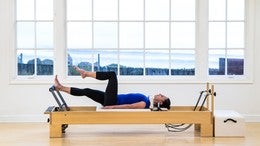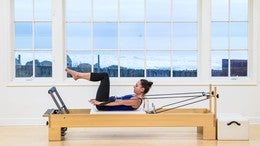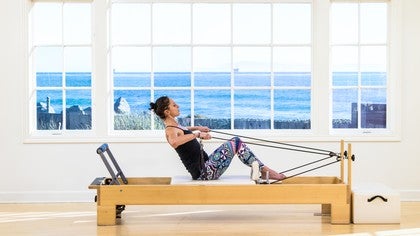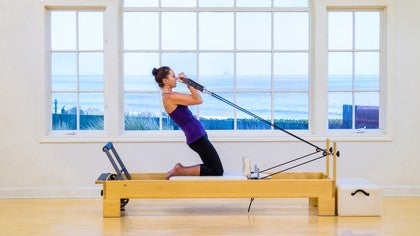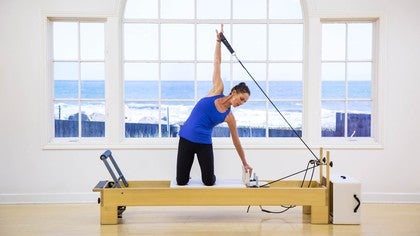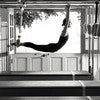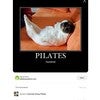Description
About This Video
Transcript
Read Full Transcript
So here we go. Next class in our progression. Are you excited? I'm excited. I have a box.
You can see that. I have a blue spring on the setup and I'm standing on my feet so you should too. So, finding your weight equally over your feet. Take just a second to organize yourself. I always need a second to check in, bring myself into my body, so let's do that together.
What does that mean to you, to bring yourself into your body, to bring yourself into your focus? Take the arms forward and let 'em just float. What does it feel like to let your arms float? I don't have the answer for you. You might.
I know what it feels like to me. It feels floaty. And then reach out, now push, but go wide with the arms, reach, and just as you come about to the t, let 'em float again. So I like to play with, float, how can we create; create, literally, different feelings, different energy. So we take the arms and we float them.
And then we open and we press and we stretch and reach, so expansion, and then ease. And let's do that the other way, so go out, push, reach, lift the body. And then just let the arms fall down the front, and reach, creating energy, creating spacial awareness, creating, I don't know, creating what you feel like creating in your body right now. And bring the arms down, and as they come down this time, I'm gonna bend over and put 'em on the box. And as I come to the box, what I'd like for us all to do is to round the spine, drawing the scapula down the back, press the pelvis forward, so you feel, maybe, the abdominals working, or you should.
I hope you do. And maybe there's a little bit of back of the leg working as well. And then, want us to tip our pelvis up and back. Gonna send the spine out, so reaching the down, finding a long back. Pause and inhale.
As you round, bringing the box to you, push the box away from you, so create resistance. Inhale, reach the spine long. Feel the sitting bone spreading out. Feel the front ribs nestling against the back ribs. So we're not overextending through the rib cage, and then round, push the box away.
Take both hands to the left. Reach out with the spine, same as before, but this time reach across, out and across to the left. And then push the box away and round in, so just some easy spinal movement. As you take your spine over, can you keep your pelvis squared, but look right underneath that outside arm, and exhale coming back in. Reach out.
Center. Exhale, round the spine. Undulating through the body, rippling. So, can we create both ease, going to the right now, both ease and strength at the same time? Round.
Can we create both ease, and strength, and fluidity at the same time? And one more, can we do that all with integrity of movement and precision? That's a big, loaded question in there. Coming back in. So I'll let you think about that one for a while.
I'll think about it with you. Reach out and down one last time in the center. Allow this time for the spine to open. Maybe it hyper extends. Come back to the straight line, curl in.
Bend your knees. They'll touch the foot bar, reach down. Set up your springs for your footwork. I've got three reds and a blue. Let the arms reach down again, and just roll yourself up one last time, bringing your arms up, up, up, and opening out to the side.
And once we get there, we're gonna sit on the box. So sitting just at the edge of the box, bring your arms out in front of you, inhale, press down on your foot bar with your feet, exhale, curl your body back. So rounding, feel the lower back come into the contact with the box. Inhale, arms come up. Open out to the side, exhale curl forward, and lift.
And now, exhale, roll back, reach back. Inhale, reach up. Keep the stability of the spine open, forward and control the up. And again, inhale and exhale, and reach up, and out, and roll up, like you're scooping up something heavy. You are; your body.
And back, so the arms are light, and then as they reach down they scoop you up, they gather you up, and you lift up again one more time. Exhale as you round back, feeling the weight of the pelvis gently shifting to the lower spine, come into contact with the box. Inhale wide arms, exhale reach down, scoop yourself up. And inhale. Prepare yourself for some challenge.
Coming back, lifting one leg, lifting the other leg, hands come to the tops of the knees. Press down on your knees, curl your chest to your thighs. Reach out, inhale and back. So this is the same abdominal series we did last time just up on the box, it's a little bit more challenging. So we could but still, we feel the stretch and the contraction in this, the double leg stretch.
And we'll do four, pull back, three, pull back, two, pull back, one, hold here. Push down on your knees, take your right knee into your both hands. Left leg reaches out straight. We're gonna push down on the knee, push down on the knee, and two. Feel that you're both pushing the bent knee away and pulling it towards you at the same time.
How can you do that? Push it away and pull it in at the same time? So we're just creating abdominal energy, and switch, and as the legs pass one another by, the pelvis stays supported and still. We'll do two, and one. Hands come behind the head.
Rotate to that bent leg. Lift and rotate, being careful not to go too far, so we can see it right on top of the box, as we rotate the underneath rib comes towards the spine, and we reach over the top rib, over that, and exhale, and five, keeping the head heavy in the hands, four, letting the gaze go just outside the thigh, three, stretching the straight leg long, two, (exhales) one. Bring both knees in. Hold the back of the legs. Curl, curl, curl and with control can we roll up.
Place the feet down. Lift the back up. And get down. Put the box away, and put the foot bar up, and lie down. I don't know about you but, that was hard for me.
Mkay. So, heels and feet on the foot bar. I'm gonna lift my head rest. I like to be up, and here we go. Feet are on the foot bar, and parallel the arms are down at our sides.
The ribs are down on the mat. Tailbone is down on the mat. Push away and pull back. We create rhythm with breath. Exhale and inhale.
(inhales and exhales) Making sure to straighten the knees completely, but also not let them overextend. We'll do three, pull back, warming up the body, and this way too, one, and pump the legs. Halfway. So feel that you're pushing and pulling, so there's no wasted movement. Last three, two, press out, and bend.
Moving to the toes. Press out, so we can stabilize the feet. Right here the feet are as lifted as we can be, in good ankle alignment, and we bend and reach. Thinking about, can we get the legs to work evenly? Can we get the knees to straighten at the same time?
Can we feel both sides of the ribs equally on the mat? Now for me that's a big challenge. We're doing two more, and we drag in one more, coming almost all the way in, we're past halfway and then push, pull, two, work the springs, feel the backs of the legs working, four, three, two, one. Press the carriage away, bring the reformer in. Heels together, toes apart, wrapping the toes around the foot bar.
Squeeze the heels, wrap the back of the legs, pres, pull, in, out and pull back. Feel that stillness in the heels. The heels are still in place. Check in with your arms and shoulders. Neck is long, shoulders are soft, so we now go four and pull back, three, and resist, two, and one.
Bend and out, pull. So it's not a bounce, it's a working contraction through a range. Small range, yes. Last four, three, two, stretch long. Bend the knees.
Heels on the outside of the foot bar. Inner thighs turned on. Stretch away, bring the carriage back. Stretch away, bring the carriage back. Feel that the inside line, the inside line of the thighs is constantly active.
The feet are flexed and still like there's a wall that they could stand on, and here's our last four, legs straightening at the same time, three, ribs soft, one, and out in, two, three, that working contraction through the range. Last four, three, two, one. Stretch the legs to straight and bring the reformer in. Moving on to the toes, keep that same open-knee position, feet and thighs pulling actively inwards as we stretch and bend, out and back. (exhales) So again, using this to warm up the large muscles in the body, to prepare the body for more intricate movements.
Last three... Two, and one. And now small, out, in, three, soft through the ribs, soft through the shoulders. I say that a lot 'cause I'm just reminding myself as much as I'm reminding you. (inhales and exhales) Last two and out, and bend.
I speak to myself about being soft a lot, not just in Pilates. Press out all the way, and heels go under, and up. It's challenging these days to move through life softly, in my world anyway. So we drag the heels and flow, and drag under so there's a heaviness and a lightness. Heavy, articulating through the foot.
(exhales) Four more, three, two, and one. Now from here, we'll alternate. Lift, reach, lift, reach, so that both feet are working, both feet have a job. One pushes and one drags or drops or pulls. All those words mean the same thing to me about what's going on with the bottom leg, the heel reaching under the bar.
We're gonna do three more to each side. Making sure that that knee is tracking straight up. Last time, stretch under, pulling that heel right down under the bar, wrapping the toes around the top. Switching sides. So it's bend the knees and come in.
What would happen if we tried to take the legs out over the foot bar? I know what might happen with me, but I'm not gonna tell a negative story, so we're gonna let the knees maybe soften over the foot bar a little bit. We're gonna roll up, see? No negative stories, no stuck. Isn't that a surprise?
Okay, so we roll up and we change our spring. Let's go to a red spring. Turn around. Take the head rest down. Put yourself so that you've got a little bit of space behind you on the reformer and reach for your straps with your hands.
Wanna hold above the buckles. Lift the spine tall, arms out in front. I'm just making sure that we're in the center of the reformer. We're gonna exhale and roll back. So we've got some spinal mobilization happening here, and exhale to resist the pull of the springs.
Round over the thighs, lift the spine tall. Exhale around back. Inhale, exhale, round over the legs. Lift the spine tall, exhale round back. Now can we do just a few, just little curls?
Now can you curl your spine forward without actually moving the carriage? It's an interesting challenge. It's gonna be small. We'll do five. Breathing out to curl.
Last time. Come all the way up, over the thighs, lift the spine. See this is all about using the abdominals to mobilize the spine. In a minute, we're gonna use the abdominals to stabilize the spine. Rotate to the left.
Curl without moving the carriage and back. Just tiny like you're bending inwards more than you're moving up and down. (exhales) Two more. (exhales) Last time. (exhales) Center.
Other direction. (exhales and inhales) Getting those abdominals nice and warm. (exhales) Last two. (exhales) Last one. Come to center.
Roll up in center. Sit up but lean back and then bend the elbows back to the sides or out to the sides, point the elbows towards the floor and just lift the back, lift the back, and straighten the arms forward. We're just gonna do one more. Just feel like it's nice after being in pretty significant flexion. Just get a little bit of back extension.
And forward. So now what we're gonna do is we're gonna take those straps over our knees. So step through. So if you feel this in your lower back, take the straps off and do it without the straps. It's not a lower back exercise.
We want the abdominals to be the focus of the movement. If you feel your lower back a lot, probably the hip flexors are working harder than the abdominals. Okay, so scooting to the position where you can just reach the shoulder blocks when you're lifted into your round spine position, and the bringing the knees up. Holding on, finding a good position. Hands come behind the head.
Now, keep the spine still as we stretch and then bend. Inhale the legs reach away. Exhale and bend. Inhale, this is tough, and exhale and bend. Just two more.
Out and drag in, and out and drag in. Reach behind the thighs, drop the feet. Curl up, curl up, curl up. Find your balance, you're rolling like a ball, balanced position, and then roll back down, bringing the springs with you, working with control. (exhales) (inhales and exhales) Hands behind the head.
Stretch the legs out. Rotate as the knees bend. Come back to the center as the legs straighten. Rotate as the legs bend. Try to not let the elbows do your rotation, but the rotation instead, comes from the ribs, so we can see where we might learn this movement in the criss-cross or the chest lift with rotation, before bringing it up onto the equipment, and challenging it with weight.
(exhales) Last one, center and rotate, and center and rotate, and then center, oh, and bend the knees. Curl, have control, control. Take the straps off the knees. Put them down. Add a blue spring, and lie down.
So, pressing off to bring the feet into the straps, if you can. Maybe that's the most challenging skill of them all. Alright. So heels together, toes apart, gonna bend the knees, and stretch the legs, and bend the knees, pull the heels in, and pull the carriage with the center of your body so, think about the legs going straight because the abdominals are pulling the carriage back. Now is that biomechanically possible?
Maybe not. Is that energetically possible? Perhaps. Lift the legs up. Bend the knees into a long, diamond position, and drop heavy through the hips.
Now think of turning the knees open to push the legs away. So we're working our external rotators here, and lift. Inhale, push the knees away, drop the straps, or push the carriage, and lift. Just a variation on some hip work; a variation here. And back.
You wanna feel that the movement of the carriage is happening in the back of the body. And up. (inhales) And out. Now hold here. Is it possible to straighten the legs without moving the carriage?
I'm gonna tell a story that it is. So how do we do it? We lengthen. Then, keep the carriage still by rotating in the hip joints. Lift the legs.
Here, it's a little bit easier to stretch the legs toward straight, sync, sync, sync through the waist, and bend. We'll do three. Wrap press down. Stretch the legs long. Keep the carriage still.
Oh yeah, it's not easy. And bend, and lift. And stretch, get that length through the legs. Hips are in external rotation, and bend. And reach away, and pull through the waist.
Let the femur bones sink or go deeper into the hip sockets as the legs stretch out. Bend, lift, stretch the legs up and we'll do five circles in each direction, reaching down and together. Inhale. Keep the pelvis heavy. Open both legs, press together, and inhale, open, and both legs down and together.
Last two. (exhales) Feel that your legs could reach away from you as they press down and then reverse that out around together at the top. Press down, lengthen out through the waist, open up and together. (inhales and exhales) So this direction for me, particularly, is a little bit more challenging to make the legs move absolutely evenly. So, maybe it is for you, maybe it's not, but let's watch for that.
Let's look for that in our own experience here. Last time. (exhales) So now we're gonna press the legs down. What I want us to do is bend the right knee, stretch the left leg out to straight. So the thighs are coming equidistant from each other, just one leg is bent and one leg is straight.
Now pull with the straight leg to bring the legs back together, and change. Just pause there for a sec, 'cause we did on the other side. And switch so the thighs, the upper leg, are equidistant to one another. One knee is bent, one leg's straight. We pull with the straight leg.
Inhale into the stretch, exhale, pull back to center. Can we do this without any instability in the pelvis? That's the big question here. No instability in the pelvis. Reach long out of that straight leg, and then pull back.
It's real tempting to wanna push and find your like momentum with the leg that's bent, it's easy. But not we don't. We pull from the straight leg. But we also have to work the bent leg enough to continue to be stable in the hips. We're going one more time to each side.
(exhales) Last time. (inhales and exhales) Bend both knees. Flex your feet. Short spine. I'm gonna take the legs out in front.
Point through the toes. Fold yourself in half. So this is the alt where we wanna come all the way into the stopper. Gonna roll up onto the shoulder blades. As we do that we're gonna try to keep the carriage still.
Bend your knees to your shoulder blocks. What's this? It's kind of like an upside down double leg stretch. And then roll down, letting the thigh bones drop towards the body, keeping the reformer still as the pelvis drops down. Flex your feet.
Keep that angle in the knees consistent, reach across the top and forward. Press the legs out straight. Fold in half. Using the abdominals, drawing in, supporting the spine, roll up. Don't push into your straps.
Definitely stand in your strap so that the straps don't go slack, but we're just holding weight against the straps. We're not pushing the straps away at all. And now we're gonna roll down, opening the knees slightly and then allowing the thighs to drop. Flex the feet, try to keep that shape. Bring the legs over the top, and out straight.
We'll do two more. Point, fold in half. Articulate the spine to lift. Bend your knees. Roll away from your feet.
Drop your thigh bones. Check your arms and shoulders. Check the tension in the back of the neck, or the lack of tension. Flex through the feet, bring the legs down, press out. One more, folding in half, coming in, articulating up, bending, and coming down.
(exhales) Flex and finish. Okay, so now we're gonna take the feet out of the straps, and we're gonna bring 'em on to the foot bar. Come all the way in, hang the straps up, come up, and take off the blue spring. So last time we did the kneeling lunge. This time we're gonna do the kneeling lunge and we're gonna add a little bit of balance to it.
So what I want us to do is come up on to the right knee. Put it up against the shoulder block. Left leg comes up on to the foot bar. So finding your stretch, pausing for a couple of breaths, and then bring, just like before, the pelvis goes straight back. We're looking for a flat back.
(exhales) I don't think mine is completely flat, so I'm doing my best but pardon me for my imperfections, if you would just for now, and then come back in. So what we're gonna do now, make sure you've got a nice, solid, grip on the bar with your foot. Take the arms away. We're gonna reach out, pressing that leg out towards straight. Yep, adding a little bit of balance, and bend.
Maybe instead of arms out to the side, it might make more sense to have your hands on your pelvis, so you could feel for stability. Either way. I kinda like the rudder that I get with my arms out to the side. Is that the right word? Last one.
Out, and in. And then reach down and take the bar again and reach one more time, out into that hamstring stretch, squaring the pelvis, lengthening the spine. And let's bend and come all the way back and keep the left hand on the bar. Take the right arm up and just side bend. Pull yourself over to the left, and come back.
Switch sides. Left foot goes up against the shoulder block, right foot comes up onto the bar. Bring the pelvis forward, lift the spine. We just find our hip flexor stretch first and pause. And then we're gonna bring the spine backwards, squaring the pelvis, lengthening the back.
(breathing) And then bend in. So here we go, and bring the arms out to the side, or we bring the arms on the pelvis and we press the front leg out towards straight, squaring the body, and bend. That front leg goes out towards straight. (exhales) And bend. Last time.
(breathing) Is keep your cool a good cue? That's what I'm telling myself silently. Keep your cool. You got this. Hands on the bar, stretch out, square the pelvis.
The hips go straight back. Spine elongates long. (exhales) Okay, bend and come back in. Take the leg down. Turn around.
We're gonna do a kneeling arm series today. So coming up against the shoulder blocks with the knees, taking a hold of the straps. (breathing) Find an elongated position with the pelvis right over the knees. Make sure you're not leaning back. Not even a little bit.
That makes it so easy, this position. You wanna get right up over the knees and take the arms back and down, and forward. (exhales) Back and down, so the shoulder blades go down the back as the arms press. The abdominals pull into the spine, following the direction of the arms. The arms stay close to the body.
Check every once in a while, each time your arms go back, that you're not leaning back with them, but instead you're going up, getting taller. I'm gonna do three more. (breathing) Two more. (exhales) And one more. So as we progress, we still wanna incorporate simple movements; simple movements interspersed perhaps, with movements that are a little bit more challenging.
I've changed my spring to a blue, and we're gonna bring the feet up against the shoulder blocks. So let's sit down on the feet and just maybe pause there. Give our feet a stretch while we pick up the straps. Bring ourselves up on to our knees. Feet are flat up against the shoulder blocks.
Take the arms straight up. Rotate the palms faced forward, and then reach the arms out to the side. We did this earlier, right? But we can't float the arms or what does it feel like to float the arms against resistance? (breathing) And then reach.
(exhales) And forward inhale, all the way to the ears, and exhale, and keeping the body stable, stationary, reaching up and out. Just do two more, up. So as the arms go out, keep the scapula wide. Keep the arms just in front of you, just in your periphery. Up (breathing) and open, and now we're gonna reverse.
Make sure you're moving your carriage as your arms reach up. Palms face up as we bring the arms down, and then reach up, scapula sliding down the back, and arms coming down the front. So now we pull away while we reach into that stretch. And we'll do two more. Maybe we can feel that the arms are easy as they come down.
Last time. And now bring the arms around again, up to the top, first fingers and thumbs together, elbows in your periphery, and then wide, and then push up and bring the elbows back. Keep pressing forward with the pelvis, pressing forward with the pelvis, to keep the body in an upright position. Scapula slides down the back, so we move not from the hand stirrups but from the shoulder blades first, and keep drawing the abdominals in and back. (exhales) Last two.
One more. (breathing) Take the arms out to the sides and bring them down. Hold both straps in one hand. Reach down and add a red spring, so now I have a red and a blue. Come back up.
Lift the arms up as high as you can behind you without elevating your scapula, keeping your body upright, and then bend the elbows. The elbows should point straight back and bend. So you reach back where you get that opening through the chest, that shoulder stretch, and then the arms stay stable, as the elbows bend. I just caught myself leaning forward a little bit, so I'm gonna bring myself back upright. So there's constantly a checklist that we could go through.
What are the shoulders doing? Where is the spine? (inhales and exhales) And those checks, check-ins get more and more complex, right, as the movements become more complex. Last time. (inhales) So you're gonna reach down and set the straps down.
So we learned a round back scooter. Now we're gonna learn a round back knee stretch. You can keep the heavier spring. Keep the red and the blue if you want. I'm gonna go down to a red.
Hands on the bar. So we're gonna draw in. Feel that the round comes mostly around the rib area, rather than locking the pelvis under. Float up off the heels, and then take the carriage back as far as you can without changing the organization of your spine and draw in and out and then in, so there's a rhythm. (exhales) And what do the abdominals do?
They resist the in of the carriage, they resist the in of the carriage, so there's stability while there's mobility. Spinal stability, trunk stability, hip mobility, pause. Flatten the back. Continue with the legs. So it's a little more challenging for some to find that sense of drawing in, of using the abdominals when the spine is straight, rather than when the spine is round, and that's just a real challenge, but it's possible.
(exhales) Last time. Exhale to bring the carriage in. Now moving through into the down stretch. Learn the down stretch, bring the hips forward, shoulders open, back of the legs and abdominals support the position of the pelvis. We take the legs, take the body backwards, and then we reach up, pulling the bar apart with the arms.
Press the carriage away. Pull the bar apart with the arms or more than just the arms with the shoulder blades, and press out, and pull in. And press out, and pull in. One more. Press out, and pull in.
Okay, so sit back, step up, keeping that same spring. Gonna step back up against the shoulder blocks. So finding a flat back. I don't have any way to find if I'm flat. I'm feeling into it.
This is a really challenging thing for me to find. We're gonna go out and pull in, so it's just the legs that move out, spine is stable, pull in. And inhale and pull in. So this is the, one of the elephants, a same movement pattern as the elephant, with the heels in a slightly uplifted position. And in.
Now what I want us to do is keep the shoulders totally still. We're gonna lift the head and lower the pelvis. We're pivoting around the shoulders into a plank position. And now take that pelvis up, and pivot around the shoulders until your body is back into a upstretch. Shoulders still.
Shoulder joints still. Pivot around the shoulder joint, and pivot back. So we're not moving back and forth essentially with the arms, they're staying still. This is setting us up for another exercise on another day. You wanna practice this, get good at this.
Know where you are in space in relationship to this movement. And then let the heels come down and turn around. And sit down on the bar. Putting the hands on the bar, just on the outsides of the hips. Press with the hands to lift like you're about to lift your hips off the bar, cause you are about to lift the hips off the bar.
What I want us to do is when we lift the hips off the bar, not to let the shoulders sag. So where are we gonna do that? Right in the center of the back, below the shoulder blades. We lift off, holding those scapula nice and still, so we're gonna just let the shoulder blades lift a little, we're gonna press them back down. Just knowing what it feels like when the shoulder blades come out of place.
One more time. And up, so now hold the shoulder blades still, and bend the elbows to the back and press up. Shoulder blades still, bend the elbows to the back, and press up. Bend, press up. Last two.
This is also setting us up for something. I've got a plan. We're gonna practice this for a while. And press up. Step down.
Step down, and get your box. So last time we did the side over position, side over on the box position. Today we're gonna add some moving to it. So that's fun. And take the foot bar down.
Hang up your springs. We want all the springs. And get your strap. (clanking) Put your foot underneath your strap, and put your other hand down on the headrest. So lifting the leg into the strap, check down the front of your body.
Make sure you're in a straight line. One hand comes behind the head. The other hand comes behind the head. So this was our exercise last time, just this. So today we're gonna go, inhale over, and exhale, create the straight line.
Inhale over, exhale create the straight line, which has a lot to do with lifting the bottom ribs. And over, and out. If it's too hard take one hand away. Last two. And up and out.
One more. (exhales) And then reach down and reach over your head and enjoy the reward. This is the reward. I like to take my hand to the front of the reformer in front of me and let the pelvis open, and roll slightly backwards. Feel free to play into that or to move into a place that feels good to you and then turn, and then stretch out long this way.
One hand on either side of the reformer. And then help yourself up and change sides. It's a big step. Okay so then we're gonna lean over. We're gonna put the bottom arm down onto the head rest.
Find your straight line. Remember the bottom ribs. Those are the most important thing to create that line. Hands behind the head, and now we go over and we reach out. Over, (exhales) breathing.
(exhales) Keeping the leg that's underneath the strap straight, and still. Is this five? I think this is five. I sure hope it is, because I'm gonna stop. So we go down.
Hand comes down, arm reaches, reaches, and now maybe we hold the front of the reformer and maybe we let the pelvis roll open. Maybe we decide that it's a nice place to have a deep breath. And then rotate. Maybe you're making different decisions and that's okay, too, right. And then just find your stretch, and then come up, take the foot out.
Turn the box long ways and take the springs down to one. One red spring. Get onto the box. Taking the straps in our hands, let's wrap the straps around the hands and bring the arms quite far forward. So organizing here, feel the pelvis, the whole pelvis, heavy on the box, and then stretch the legs so it feels like they might just lift, but really they're reaching, and then start pulling from the scapula, from the scapula we pull and as the arms come back, they push down and we reach up with our body.
And resist back. So do we start from our hands? No. We start from our shoulder blades, sliding down the back. Then the arms begin to lift.
Then the spine lifts, pressing away down towards the feet, and then slowly down. Scapula sliding back, spine reaching out, and resist. So just a few more. Up and out, and resist. Keep your arms close to the reformer.
Up and out, and resist. Last one. (exhales) Up and out. Okay, and we hold it there, and we push into the straps and lift the spine up even more. Lower the body.
Lower the arms. Lower the legs. Let the body just rest for a moment, as you hang up your straps. Step to the side. Come around to the front.
It's a little heavier than what we started with now, but it'll be fine. So we'll just finish. We'll come full circle here, around through the spine. Dive down into the frame with your back, find your long, flat back. Push, here you get a little bit more resistance against the heavier spring, which is nice.
Let's get that stretch through the back. And reach out, diving down, and then press the box away, round, undulating the spine. Feel all the movements, as we feel that shift from the flat spine and then the energy just ripples through the back. Reach up and find a stretch, and then standing on the feet, take the arms up towards the sky, as we stand up all the way, and softly let them open, and fall. (exhales) And practice that for a while.
Pilates with Meri Rogers: Fundamental Reformer Progressions
Comments
You need to be a subscriber to post a comment.
Please Log In or Create an Account to start your free trial.
